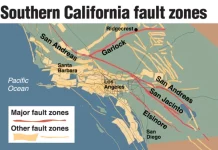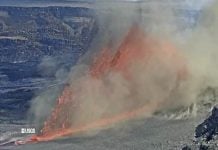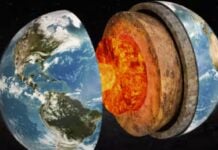
University of Southern California scientists have proven that the Earth’s inner core is backtracking — slowing down — in relation to the planet’s surface, as shown in new research published in Nature.
Movement of the inner core has been debated by the scientific community for two decades, with some research indicating that the inner core rotates faster than the planet’s surface. The new USC study provides unambiguous evidence that the inner core began to decrease its speed around 2010, moving slower than the Earth’s surface.
“When I first saw the seismograms that hinted at this change, I was stumped,” said John Vidale, Dean’s Professor of Earth Sciences at the USC Dornsife College of Letters, Arts and Sciences. “But when we found two dozen more observations signaling the same pattern, the result was inescapable. The inner core had slowed down for the first time in many decades. Other scientists have recently argued for similar and different models, but our latest study provides the most convincing resolution.”
The relativity of backtracking and slowing down
The inner core is considered to be reversing and backtracking relative to the planet’s surface due to moving slightly slower instead of faster than the Earth’s mantle for the first time in approximately 40 years.
Relative to its speed in previous decades, the inner core is slowing down.
The inner core is a solid iron-nickel sphere surrounded by the liquid iron-nickel outer core. Roughly the size of the moon, the inner core sits more than 3,000 miles under our feet and presents a challenge to researchers: It can’t be visited or viewed. Scientists must use the seismic waves of earthquakes to create renderings of the inner core’s movement.

A new take on a repetitive approach
Vidale and Wei Wang of the Chinese Academy of Sciences utilized waveforms and repeating earthquakes in contrast to other research. Repeating earthquakes are seismic events that occur at the same location to produce identical seismograms.
In this study, the researchers compiled and analyzed seismic data recorded around the South Sandwich Islands from 121 repeating earthquakes that occurred between 1991 and 2023. They have also utilized data from twin Soviet nuclear tests between 1971 and 1974, as well as repeated French and American nuclear tests from other studies of the inner core.
Vidale said the inner core’s slowing speed was caused by the churning of the liquid iron outer core that surrounds it, which generates Earth’s magnetic field, as well as gravitational tugs from the dense regions of the overlying rocky mantle.
The impact on the Earth’s surface
The implications of this change in the inner core’s movement for Earth’s surface can only be speculated. Vidale said the backtracking of the inner core may alter the length of a day by fractions of a second: “It’s very hard to notice, on the order of a thousandth of a second, almost lost in the noise of the churning oceans and atmosphere.”
The USC scientists’ future research aspires to chart the trajectory of the inner core in even greater detail to reveal exactly why it is shifting.
“The dance of the inner core might be even more lively than we know so far,” Vidale said.
More information: Wei Wang et al, Inner core backtracking by seismic waveform change reversals, Nature (2024). DOI: 10.1038/s41586-024-07536-4
There is research showing a correlation between solar activity and a variety of activity, and phenomena, on Earth… Whilst seemingly minute, the consequences of the slowing down of Earth’s inner core may be rather profound; and, considering the variety of ‘unusual’ phenomena seemingly on the rise on our planet, we may actually be seeing evidence of this minute change… RIGHT NOW!
Hey friends, it’s time to wake up!
If a few more people choose to support my work, I could expose more lies, root out more corruption, and call out more hypocrites. So, if you can afford it, please support my endeavor by either using PAYPAL or the DonorBox below (PAYPAL & Credit Cards / Debit Cards accepted)…
If you are a crypto fanatic, I do now accept crypto donations:
BTC: 1AjhUJM6cy8yr2UrT67iGYWLQNmhr3cHef (Network: Bitcoin) USDT: 0x490fe5d79d044a11c66c013e5b71305af0a76c1b (Network: Etherum ERC20)
You should join my newsletter to get a daily compilation of different breaking news, pictures and videos… YOU WILL LOVE IT!
Thank you,
Manuel













Yes it’s part of pole shift.